[English] 日本語
 Yorodumi
Yorodumi- PDB-6o3h: Icosahedral reconstruction of the thermophilic bacteriophage P74-... -
+ Open data
Open data
- Basic information
Basic information
| Entry | Database: PDB / ID: 6o3h | ||||||
|---|---|---|---|---|---|---|---|
| Title | Icosahedral reconstruction of the thermophilic bacteriophage P74-26 capsid | ||||||
 Components Components |
| ||||||
 Keywords Keywords | VIRUS / Virion / Capsid / Major Capsid Protein / Decoration Protein / Icosahedral Virus / Caudovirus / Thermophilic / Bacteriophage | ||||||
| Function / homology | Major capsid protein GpE / Phage major capsid protein E / host cell cytoplasm / Uncharacterized protein / Major head protein Function and homology information Function and homology information | ||||||
| Biological species |  Thermus virus P74-26 Thermus virus P74-26 | ||||||
| Method | ELECTRON MICROSCOPY / single particle reconstruction / cryo EM / Resolution: 2.8 Å | ||||||
 Authors Authors | Stone, N.P. / Demo, G. / Agnello, E. / Kelch, B.A. | ||||||
| Funding support |  United States, 1items United States, 1items
| ||||||
 Citation Citation |  Journal: Nat Commun / Year: 2019 Journal: Nat Commun / Year: 2019Title: Principles for enhancing virus capsid capacity and stability from a thermophilic virus capsid structure. Authors: Nicholas P Stone / Gabriel Demo / Emily Agnello / Brian A Kelch /  Abstract: The capsids of double-stranded DNA viruses protect the viral genome from the harsh extracellular environment, while maintaining stability against the high internal pressure of packaged DNA. To ...The capsids of double-stranded DNA viruses protect the viral genome from the harsh extracellular environment, while maintaining stability against the high internal pressure of packaged DNA. To elucidate how capsids maintain stability in an extreme environment, we use cryoelectron microscopy to determine the capsid structure of thermostable phage P74-26 to 2.8-Å resolution. We find P74-26 capsids exhibit an overall architecture very similar to those of other tailed bacteriophages, allowing us to directly compare structures to derive the structural basis for enhanced stability. Our structure reveals lasso-like interactions that appear to function like catch bonds. This architecture allows the capsid to expand during genome packaging, yet maintain structural stability. The P74-26 capsid has T = 7 geometry despite being twice as large as mesophilic homologs. Capsid capacity is increased with a larger, flatter major capsid protein. Given these results, we predict decreased icosahedral complexity (i.e. T ≤ 7) leads to a more stable capsid assembly. | ||||||
| History |
|
- Structure visualization
Structure visualization
| Movie |
 Movie viewer Movie viewer |
|---|---|
| Structure viewer | Molecule:  Molmil Molmil Jmol/JSmol Jmol/JSmol |
- Downloads & links
Downloads & links
- Download
Download
| PDBx/mmCIF format |  6o3h.cif.gz 6o3h.cif.gz | 662.6 KB | Display |  PDBx/mmCIF format PDBx/mmCIF format |
|---|---|---|---|---|
| PDB format |  pdb6o3h.ent.gz pdb6o3h.ent.gz | 559.8 KB | Display |  PDB format PDB format |
| PDBx/mmJSON format |  6o3h.json.gz 6o3h.json.gz | Tree view |  PDBx/mmJSON format PDBx/mmJSON format | |
| Others |  Other downloads Other downloads |
-Validation report
| Summary document |  6o3h_validation.pdf.gz 6o3h_validation.pdf.gz | 1006.7 KB | Display |  wwPDB validaton report wwPDB validaton report |
|---|---|---|---|---|
| Full document |  6o3h_full_validation.pdf.gz 6o3h_full_validation.pdf.gz | 1 MB | Display | |
| Data in XML |  6o3h_validation.xml.gz 6o3h_validation.xml.gz | 103.6 KB | Display | |
| Data in CIF |  6o3h_validation.cif.gz 6o3h_validation.cif.gz | 154.6 KB | Display | |
| Arichive directory |  https://data.pdbj.org/pub/pdb/validation_reports/o3/6o3h https://data.pdbj.org/pub/pdb/validation_reports/o3/6o3h ftp://data.pdbj.org/pub/pdb/validation_reports/o3/6o3h ftp://data.pdbj.org/pub/pdb/validation_reports/o3/6o3h | HTTPS FTP |
-Related structure data
| Related structure data |  0618MC M: map data used to model this data C: citing same article ( |
|---|---|
| Similar structure data |
- Links
Links
- Assembly
Assembly
| Deposited unit | 
|
|---|---|
| 1 | x 60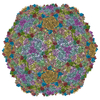
|
| 2 |
|
| 3 | x 5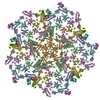
|
| 4 | x 6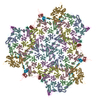
|
| 5 | 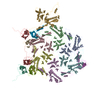
|
| Symmetry | Point symmetry: (Schoenflies symbol: I (icosahedral)) |
- Components
Components
| #1: Protein | Mass: 46680.754 Da / Num. of mol.: 7 / Source method: isolated from a natural source / Source: (natural)  Thermus virus P74-26 / References: UniProt: A7XXR6 Thermus virus P74-26 / References: UniProt: A7XXR6#2: Protein | Mass: 16376.630 Da / Num. of mol.: 7 / Source method: isolated from a natural source / Source: (natural)  Thermus virus P74-26 / References: UniProt: A7XXR5 Thermus virus P74-26 / References: UniProt: A7XXR5 |
|---|
-Experimental details
-Experiment
| Experiment | Method: ELECTRON MICROSCOPY |
|---|---|
| EM experiment | Aggregation state: PARTICLE / 3D reconstruction method: single particle reconstruction |
- Sample preparation
Sample preparation
| Component | Name: Thermus phage P7426 / Type: VIRUS / Entity ID: all / Source: NATURAL | ||||||||||||||||||||
|---|---|---|---|---|---|---|---|---|---|---|---|---|---|---|---|---|---|---|---|---|---|
| Molecular weight | Experimental value: NO | ||||||||||||||||||||
| Source (natural) | Organism:   Thermus phage P7426 (virus) Thermus phage P7426 (virus) | ||||||||||||||||||||
| Details of virus | Empty: NO / Enveloped: NO / Isolate: OTHER / Type: VIRION | ||||||||||||||||||||
| Natural host | Organism: Thermus thermophilus / Strain: HB8 | ||||||||||||||||||||
| Virus shell | Name: P74-26 capsid / Diameter: 824 nm / Triangulation number (T number): 7 | ||||||||||||||||||||
| Buffer solution | pH: 8 | ||||||||||||||||||||
| Buffer component |
| ||||||||||||||||||||
| Specimen | Embedding applied: NO / Shadowing applied: NO / Staining applied: NO / Vitrification applied: YES | ||||||||||||||||||||
| Specimen support | Details: 45 second glow discharge, negative polarity, 20 mA / Grid material: COPPER / Grid mesh size: 400 divisions/in. / Grid type: Homemade | ||||||||||||||||||||
| Vitrification | Instrument: FEI VITROBOT MARK IV / Cryogen name: ETHANE / Humidity: 95 % / Chamber temperature: 283 K |
- Electron microscopy imaging
Electron microscopy imaging
| Experimental equipment |  Model: Titan Krios / Image courtesy: FEI Company |
|---|---|
| Microscopy | Model: FEI TITAN KRIOS |
| Electron gun | Electron source:  FIELD EMISSION GUN / Accelerating voltage: 300 kV / Illumination mode: FLOOD BEAM FIELD EMISSION GUN / Accelerating voltage: 300 kV / Illumination mode: FLOOD BEAM |
| Electron lens | Mode: BRIGHT FIELD / Nominal magnification: 130000 X / Nominal defocus max: 1200 nm / Nominal defocus min: 200 nm / Cs: 2.7 mm / Alignment procedure: COMA FREE |
| Specimen holder | Cryogen: NITROGEN / Specimen holder model: FEI TITAN KRIOS AUTOGRID HOLDER |
| Image recording | Electron dose: 48 e/Å2 / Detector mode: SUPER-RESOLUTION / Film or detector model: GATAN K2 SUMMIT (4k x 4k) / Num. of grids imaged: 2 / Num. of real images: 4611 |
- Processing
Processing
| EM software |
| ||||||||||||||||||||||||||||||||||||||||
|---|---|---|---|---|---|---|---|---|---|---|---|---|---|---|---|---|---|---|---|---|---|---|---|---|---|---|---|---|---|---|---|---|---|---|---|---|---|---|---|---|---|
| CTF correction | Type: PHASE FLIPPING AND AMPLITUDE CORRECTION | ||||||||||||||||||||||||||||||||||||||||
| Symmetry | Point symmetry: I (icosahedral) | ||||||||||||||||||||||||||||||||||||||||
| 3D reconstruction | Resolution: 2.8 Å / Resolution method: FSC 0.143 CUT-OFF / Num. of particles: 23174 / Symmetry type: POINT | ||||||||||||||||||||||||||||||||||||||||
| Atomic model building | Protocol: AB INITIO MODEL / Space: REAL / Target criteria: Correlation Coefficient |
 Movie
Movie Controller
Controller


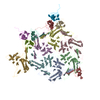
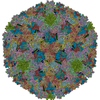

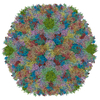
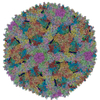
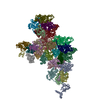
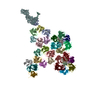

 PDBj
PDBj